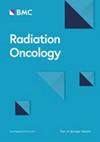FAPI-46/双示踪剂 PET/CT 成像对食管癌放射治疗管理的影响
IF 3.3
2区 医学
Q2 ONCOLOGY
引用次数: 0
摘要
成纤维细胞活化蛋白(FAP)在各种癌症的肿瘤微环境(TME)中都有表达。在我们的分析中,我们描述了使用镓-68-放射性标记的 FAP 抑制剂(FAPI-46-PET/CT)和氟脱氧-D-葡萄糖(FDG-PET/CT)进行双示踪剂成像对原发性食管癌(EC)放射治疗的影响。我们比较了 PET 造影前后的功能性肿瘤体积(FTV)、总肿瘤体积(GTV)和肿瘤分期。治疗方法的改变分为 "轻微"(调整放射野)和 "重大"(改变治疗方案)两种。对所有有可用组织的患者进行了 FAP 免疫组化(IHC)染色。在所有 FAPI-46/ 双示踪剂扫描和 30/32 (93%)次 FDG 扫描中均检测到原发肿瘤。与最初的分期 CT 扫描相比,有 12/32 例患者(38%)在联合使用 FDG 和 FAPI-46 PET 扫描后,结节状态有所改善。有两个淋巴结转移仅在 FAPI-46 双示踪剂扫描中可见。FAPI-4 -PET/CT扫描后,2/32(6%)例患者观察到新的远处转移。根据我们的研究结果,5/32(16%)例患者在接受 FAPI-46/ 双示踪剂 PET/CT 治疗后扩大了 RT 野("小改变"),3/32(3%)例患者改变了治疗方案("大改变")。与FDG-PET/CT相比,FAPI-46/双示踪剂扫描的GTV更大(平均值分别为99.0毫升和80.3毫升(P < 0.001)),核医学FTV的结果类似。IHC 在所有标本中都发现了 FAP 的异质性表达(平均 H 评分:36.3(SD 24.6)),但 IHC 中的 FAP 表达与 PET/CT 中的 FAPI 示踪剂摄取之间没有相关性。我们首次报告了对计划接受 RT 的 EC 患者使用 FAPI-46 PET 的数据。肿瘤摄取率很高,且与肿瘤组织器官中的 FAP 表达无关。此外,FAPI-46/双示踪剂正电子发射计算机断层显像对这种情况下的治疗具有相关影响。我们的数据要求对FAPI-46/双示踪剂PET进行前瞻性评估,以改善EC的临床疗效。本文章由计算机程序翻译,如有差异,请以英文原文为准。
Impact of FAPI-46/dual-tracer PET/CT imaging on radiotherapeutic management in esophageal cancer
Fibroblast activation protein (FAP) is expressed in the tumor microenvironment (TME) of various cancers. In our analysis, we describe the impact of dual-tracer imaging with Gallium-68-radiolabeled inhibitors of FAP (FAPI-46-PET/CT) and fluorodeoxy-D-glucose (FDG-PET/CT) on the radiotherapeutic management of primary esophageal cancer (EC). 32 patients with EC, who are scheduled for chemoradiation, received FDG and FAPI-46 PET/CT on the same day (dual-tracer protocol, 71%) or on two separate days (29%) We compared functional tumor volumes (FTVs), gross tumor volumes (GTVs) and tumor stages before and after PET-imaging. Changes in treatment were categorized as “minor” (adaption of radiation field) or “major” (change of treatment regimen). Immunohistochemistry (IHC) staining for FAP was performed in all patients with available tissue. Primary tumor was detected in all FAPI-46/dual-tracer scans and in 30/32 (93%) of FDG scans. Compared to the initial staging CT scan, 12/32 patients (38%) were upstaged in nodal status after the combination of FDG and FAPI-46 PET scans. Two lymph node metastases were only visible in FAPI-46/dual-tracer. New distant metastasis was observed in 2/32 (6%) patients following FAPI-4 -PET/CT. Our findings led to larger RT fields (“minor change”) in 5/32 patients (16%) and changed treatment regimen (“major change”) in 3/32 patients after FAPI-46/dual-tracer PET/CT. GTVs were larger in FAPI-46/dual-tracer scans compared to FDG-PET/CT (mean 99.0 vs. 80.3 ml, respectively (p < 0.001)) with similar results for nuclear medical FTVs. IHC revealed heterogenous FAP-expression in all specimens (mean H-score: 36.3 (SD 24.6)) without correlation between FAP expression in IHC and FAPI tracer uptake in PET/CT. We report first data on the use of PET with FAPI-46 for patients with EC, who are scheduled to receive RT. Tumor uptake was high and not depending on FAP expression in TME. Further, FAPI-46/dual-tracer PET had relevant impact on management in this setting. Our data calls for prospective evaluation of FAPI-46/dual-tracer PET to improve clinical outcomes of EC.
求助全文
通过发布文献求助,成功后即可免费获取论文全文。
去求助
来源期刊

Radiation Oncology
ONCOLOGY-RADIOLOGY, NUCLEAR MEDICINE & MEDICAL IMAGING
CiteScore
6.50
自引率
2.80%
发文量
181
审稿时长
3-6 weeks
期刊介绍:
Radiation Oncology encompasses all aspects of research that impacts on the treatment of cancer using radiation. It publishes findings in molecular and cellular radiation biology, radiation physics, radiation technology, and clinical oncology.
 求助内容:
求助内容: 应助结果提醒方式:
应助结果提醒方式:


